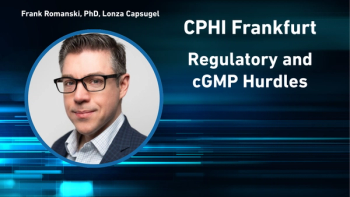
- Pharmaceutical Technology-05-02-2018
- Volume 42
- Issue 5
Harmonizing GMP Inspections
The European Union is collaborating with the Pharmaceutical Inspection Co-operation Scheme to develop similar guides for evaluating inspectorates’ competency.
The European Union’s medicines agencies, coordinated by the European Medicines Agency (EMA), are currently putting a lot of effort into establishing an international platform for the improvement of good manufacturing practice (GMP) and other quality standards. A cornerstone for this drive is a mutual recognition agreement (MRA) on GMP inspections between the EU’s 28 member states and the United States, which started coming into operation in late 2017 and is due to be fully implemented in 2019. The agreement is gradually coming into force with the help of a close working relationship between the EU medicines agencies and the Geneva-based Pharmaceutical Inspection Co-operation Scheme (PIC/S). Both have collaborated together with the Canadian medicines agency, Health Canada, to develop similar guides for evaluating the competency of inspectorates.
PIC/S was set up in 1995 as a co-operative arrangement between the inspectorates of regulatory authorities to harmonize GMP inspection procedures. Approximately two thirds of its 52 participating authorities come from Europe, most of them from the EU. The overall objective of PIC/S is the harmonizing of inspection procedures worldwide through key groups such as the EU’s inspectorates as well as through guidance documents and training programmes for inspectors. In fact, the only major European country that is not yet a member of PIC/s is Russia. But even Russia may soon be joining because it has started the pre-accession procedure for becoming a member.
PIC/S participants, all with GMP inspection systems of equivalent competence, share the objective of spreading uniformity in inspection and other quality standards in their own regions and across the world. The EU–US MRA is an important landmark in this endeavour because it means that, with Canada also having a GMP inspections MRA with the EU, there is now trans-Atlantic harmonization of inspection standards.
Mutual recognition of inspection competence
The mutual recognition deal with the US comes fully into force once the US Food and Drug Administration (FDA) recognizes that all the EU’s national competent authorities (NCAs) with responsibility for inspecting pharmaceutical plants have equivalent inspection standards to those in the US. FDA started bringing the MRA into operation in November 2017 after it confirmed the capability of eight EU member states agencies to carry out GMP inspections at the level equivalent to that in the US. The EU countries-Austria, Croatia, France, Italy, Malta, Spain, Sweden, and the United Kingdom-were the first foreign states to have their GMP inspection competence mutually recognized by FDA. The confirmation of equivalence in these EU states came four months after the European Commission decided, after an audit in the US, that FDA had equivalence to EU inspection standards (1) and eight months after the signing of the agreement in early November 2017 (2). In March 2018, FDA announced it had recognized the inspections capabilities of four more EU states-Czech Republic, Greece, Hungary, and Romania (3).
All FDA’s assessments and approvals of the EU’s remaining agencies will have to be completed by a deadline of 15 July 2019 so that the MRA can be fully implemented across the EU (2). Then the major benefits of the MRA-a big reduction in duplication in inspections in the US and EU and a channelling of more resources into GMP inspections of high-risk plants outside Europe and North America-should start to become clearer.
Joint audits
A key role in FDA’s assessments of EU national agencies is played by the joint audit programme (JAP) under which teams of EU inspectors regularly audit the inspection capability of individual agencies. The JAP is part of the work of the GMP/GDP Inspectors Working Group, which, though supported by an EMA-run secretariat, reports to the heads of medicines agencies (HMA), representing the national regulatory authorities.
FDA has been attending JAP audits of individual member states agencies as an observer. The JAP auditors use an evaluation guide virtually identical to the joint reassessment programme (JRP), which is PIC/S’ own joint auditing scheme. Both guides apply a basic auditing tool developed by Health Canada. This guide has been adapted to EU legislation, the legal needs of the three non-EU states in the EU medicines approval network, PIC/S itself, and MRA audit programmes. It was the confidence of FDA-a PIC/S member itself since 2017 after a five-year accession process-in the JAP that is laying the foundations for its approval of the inspection systems of all EU states.
“The FDA’s assessment of EU member state authorities is predominantly based on observing the [JAP] audits,” said Ian Rees and Mark Birse, two inspectors at the UK Medicines and Healthcare products Regulatory Agency (MHRA), in a joint blog in November 2017 (4). Birse led and Rees was a member of the EU team that audited the FDA inspection capabilities under the terms of the MRA in 2017.
Implications of Brexit
The Compliance Group that runs the JAP and is chaired by Rees “has been managing a demanding programme in order to meet the challenging reporting deadlines set out in the mutual recognition agreement so that the FDA could assess the EU authorities” by the scheduled completion date, the blog added (4). The deadline for the completion of the assessments will come a few months after the UK is due to leave the EU on 29 Mar. 2019. Brexit could cause problems with the UK’s participation in the EU–US MRA, but also, even more significantly, its position in the mutual recognition system that covers the whole of the EU and in which the MHRA’s expertise has been an important contributor to its success.
The UK and US may have to negotiate an MRA that would be separate to the EU–US agreement but probably identical. An MRA between the UK and the EU on GMP inspections will be more complicated because it is likely to have to be part of a free-trade agreement between the two. This agreement is scheduled to be thrashed out during a transition period to the end of 2020 to allow full implementation of an EU–UK Brexit agreement. Both sides will be anxious to avoid differences that could undermine current efforts to harmonize GMP inspection standards, especially through collaboration with PIC/S.
Uniformity between EMA and PIC/S guidelines on GMP has been coming under pressure, mainly because of divergences resulting from additions and alterations generated by the EU’s relatively busy programme for making GMP improvements. The EU has tended to make changes to its own guidelines without synchronizing with PIC/S.
According to the 2018 work plan (5) of the GMP/GDP Inspectors Working Group, the group is or will be preparing new GMP or quality guidance covering imported medicines, pharmaceutical quality systems, a risk-based approach to medicine shortages, data integrity, computerized systems, sterile drugs, finished dosage form manufacturing, and lifecycle management.
Disputes on ATMP guidance
A major split opened up in 2017 between the European Commission, which is ultimately responsible for GMP guidelines, and PIC/S over a new EU stand-alone GMP guide (6) on gene and cell therapies and tissue-engineered treatments or advanced therapy medicinal products (ATMPs). The guide, based on amendments to two annexes of the EU GMP guide, is due to come into force in May 2018.
In a letter (7) sent to the European Commission, the organization warned “about the impact on public health and the safety of patients that the [EU] ATMP GMP guideline would cause.” The letter protested that as a result of “lowering the GMP requirements for ATMP,” the PIC/S and EU GMP guide would “no longer be equivalent” after nearly 20 years of being developed in parallel and on the basis of a harmonized consultation procedure. The decision to amend the existing guidelines was “a serious setback in terms of co-operation between the EU and PIC/S” and will “add barriers in the field of GMP and make harmonization efforts more difficult,” the letter said. PIC/S has acknowledged that the European Commission dealt with some of its worries before finalizing the guidelines, but that it still had a “number of serious patient safety concerns.”
The dispute, unless resolved, could have implications for countries that require medicine manufacturers to comply with both sets of GMP guidelines. Switzerland, which is a not an EU member but whose Swiss Agency for Therapeutic Products (Swissmedic) is a participant in PIC/S, stipulates, for example, compliance with the two guidelines. Swissmedic issued a statement (8) in February 2018 saying that where there are discrepancies between the two guidelines, “compliance with both sets can in fact only be guaranteed if the more stringent requirements of the two are observed.”
The statement does not mention the EU ATMP guideline, referring only to the need to comply with an EU GMP update on avoidance of contamination risks because it is in line with current state of science and technology. In the light of the Swissmedic’s clarification, it would appear that drug companies will have to follow the stricter PIC/S code on ATMPs. Compliance to the stricter code could have repercussions for pharmaceutical companies in Switzerland, which is a centre for the development and production of advanced medicines. It could also be a hindrance to moves in Europe to harmonize GMP inspection standards because these standards are based on GMP codes.
References
1. European Union, Notification to the Joint Sectoral Committee by European Union Under Article 7 of Sectoral Annex of the Agreement on Mutual Recognition between European Community and the US, Official Journal of European Union-document 22017X0915 (Brussels, 15 Sept. 2017).
2. EMA, “Europe US regulators Agree Mutual Recognition of Inspections of Medicine Manufacturers,” Press Release, 2 Mar. 2017.
3. FDA, “EU–US MR Joint Sectoral Committee-List of Recognized Authorities Under Article 7 of the Sectoral Annex, Countries Recognised 1 Mar. 2018.” (Washington DC, March 2018).
4. MHRA blog, “EU–FDA Mutual Recognition of Inspections of Medicine Manufacturers Enters Operational Phase” (1 Nov. 2017).
5. EMA, “Work Plan for GMP/GDP Inspectors Working Group for 2018,” EMA/INS/GMP/504401-2017 (London, 30 Nov. 2017).
6. European Commission, Good Manufacturing Practice for Advanced Therapy Medicinal Products, C(2017) 7694 final (Brussels, 22 Nov. 2017).
7. PIC/S, “PS L 11 2017 Letter to EC Concerning GMP ATMP” (Geneva, 2 Mar. 2017).
8. Swissmedic statement, “Good Manufacturing Practice-Procedures for Discrepancy between EU and PIC/S GMP” (Berne, 7 Dec. 2017).
Article Details
Pharmaceutical Technology Europe
Vol. 30, No. 5
May 2018
Pages: 6–8
Citation
When referring to this article, please cite it as S. Milmo, “Harmonizing GMP Inspections,” Pharmaceutical Technology Europe 30 (2) 2018.
About the Author
Sean Milmo is a freelance writer based in Essex, United Kingdom, seanmilmo@btconnect.com.
Articles in this issue
over 7 years ago
Microfluidics Platform for Drug Encapsulationover 7 years ago
Pipette Tip for Highly Viscous Liquidsover 7 years ago
PLC System With Wireless Connectionover 7 years ago
Hygienic Magnetic Mixerover 7 years ago
The Role of Carriers in DPI Capsulesover 7 years ago
Freeze-Drying Process Optimizationover 7 years ago
Improving Visual Inspectionover 7 years ago
How to Plan Smoke Studiesover 7 years ago
Integrated Systems Aid Data Integrityover 7 years ago
Key Ingredients to Healthcare’s FutureNewsletter
Get the essential updates shaping the future of pharma manufacturing and compliance—subscribe today to Pharmaceutical Technology and never miss a breakthrough.




